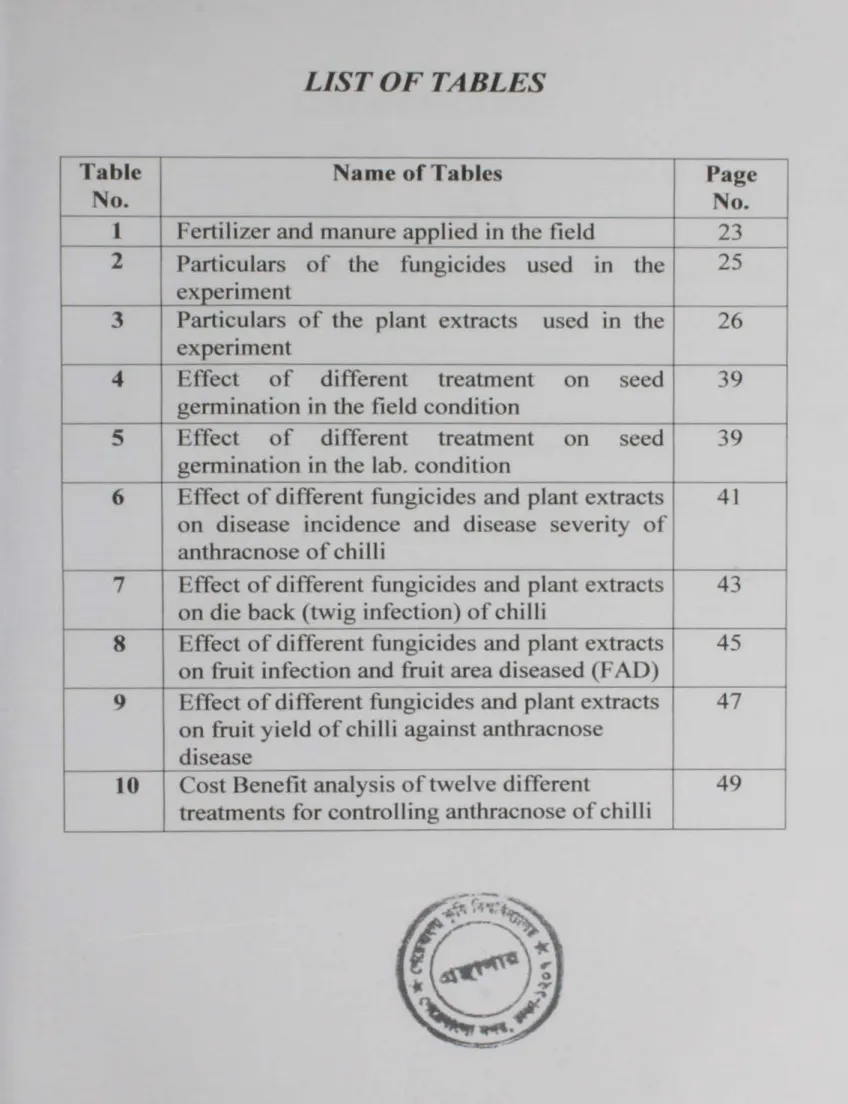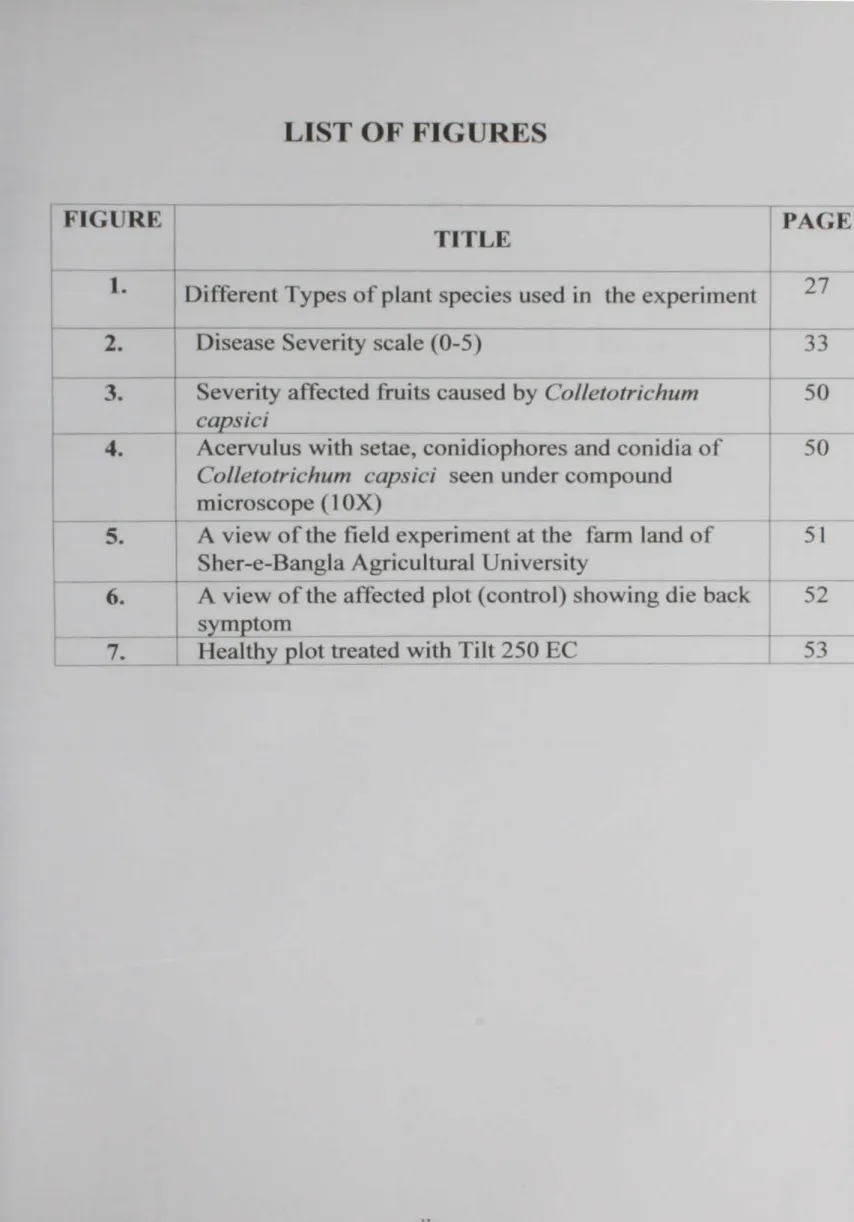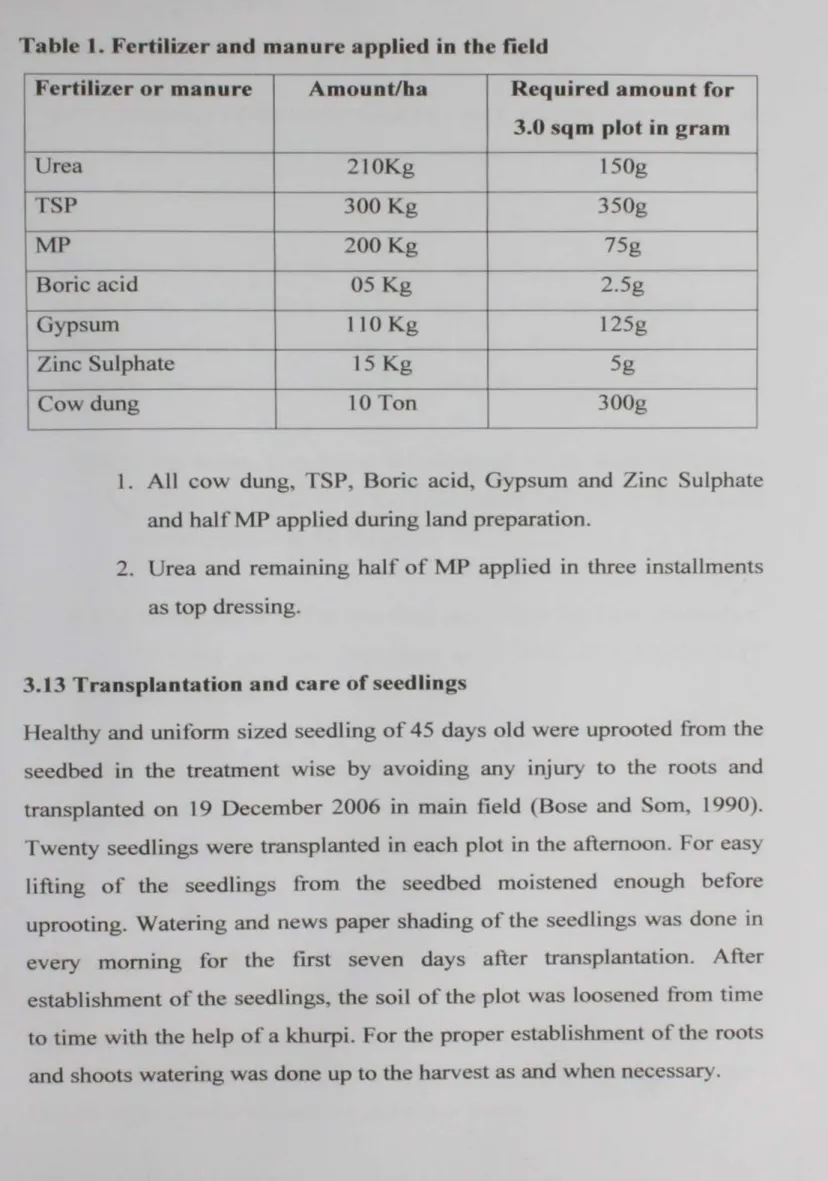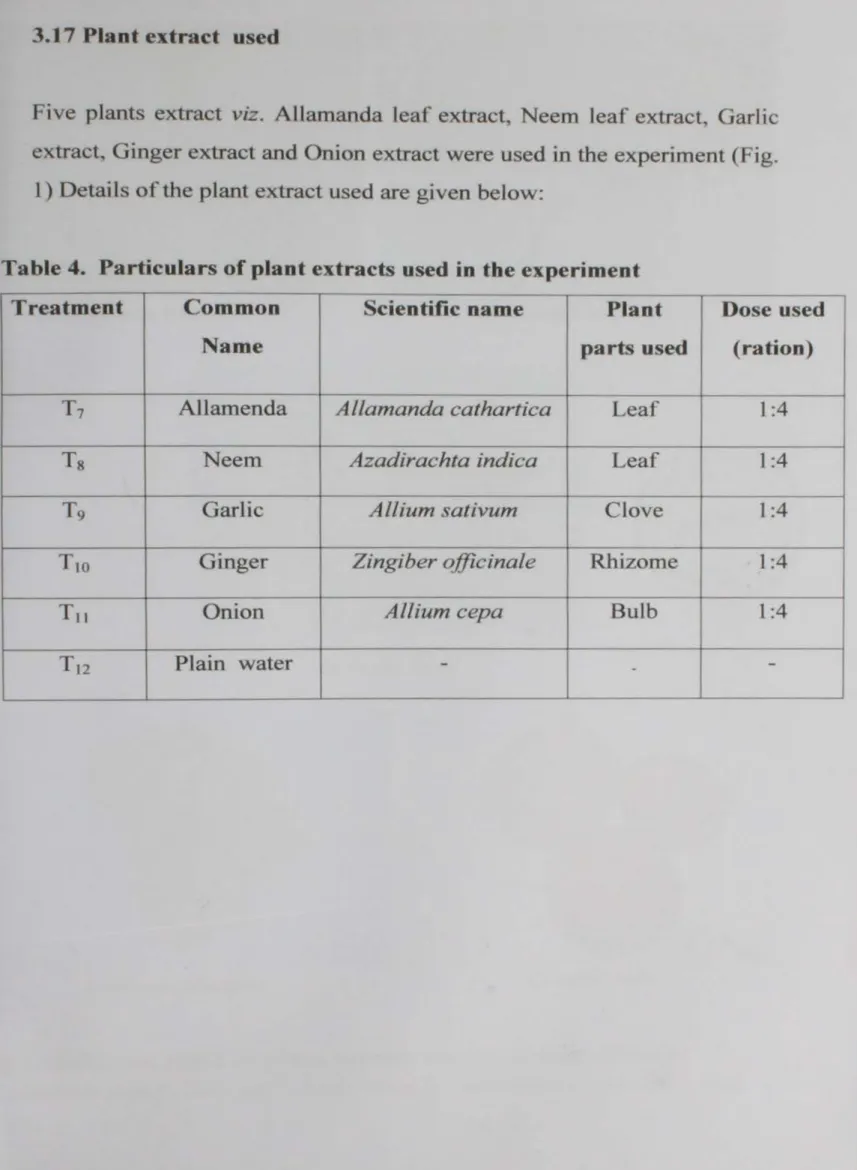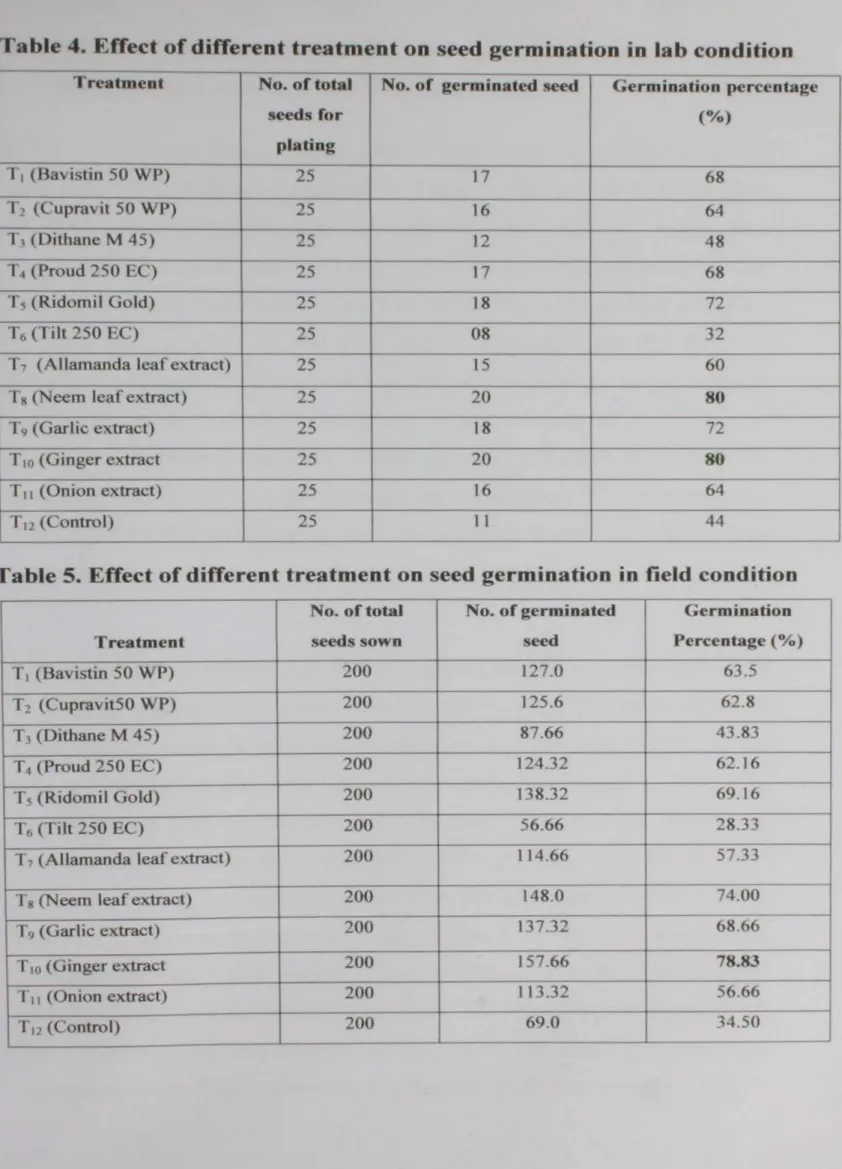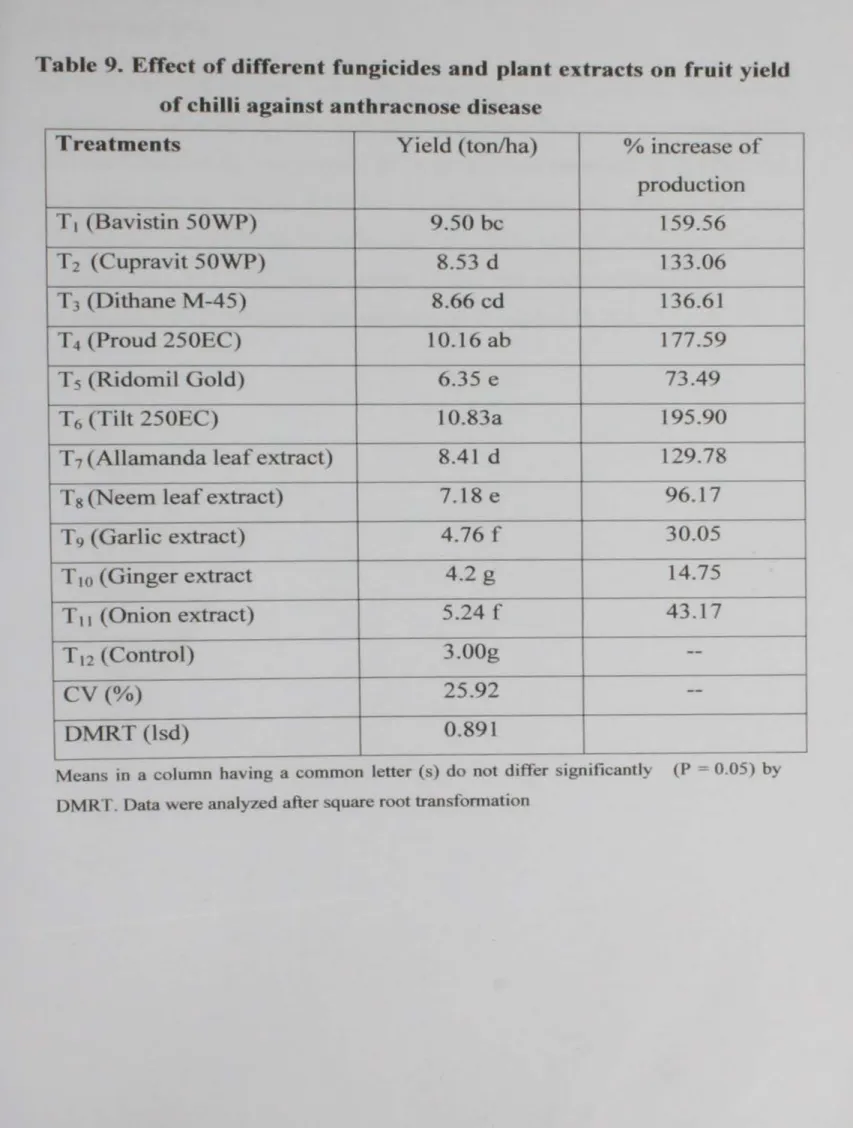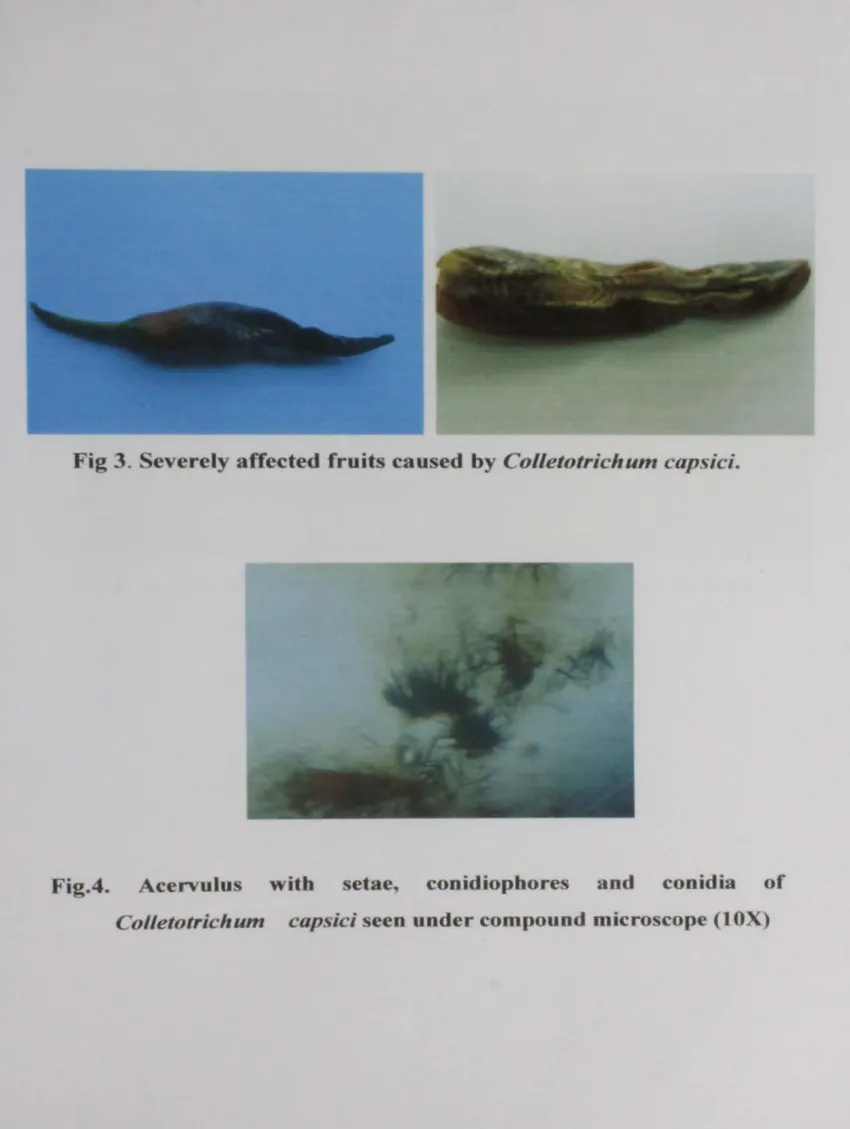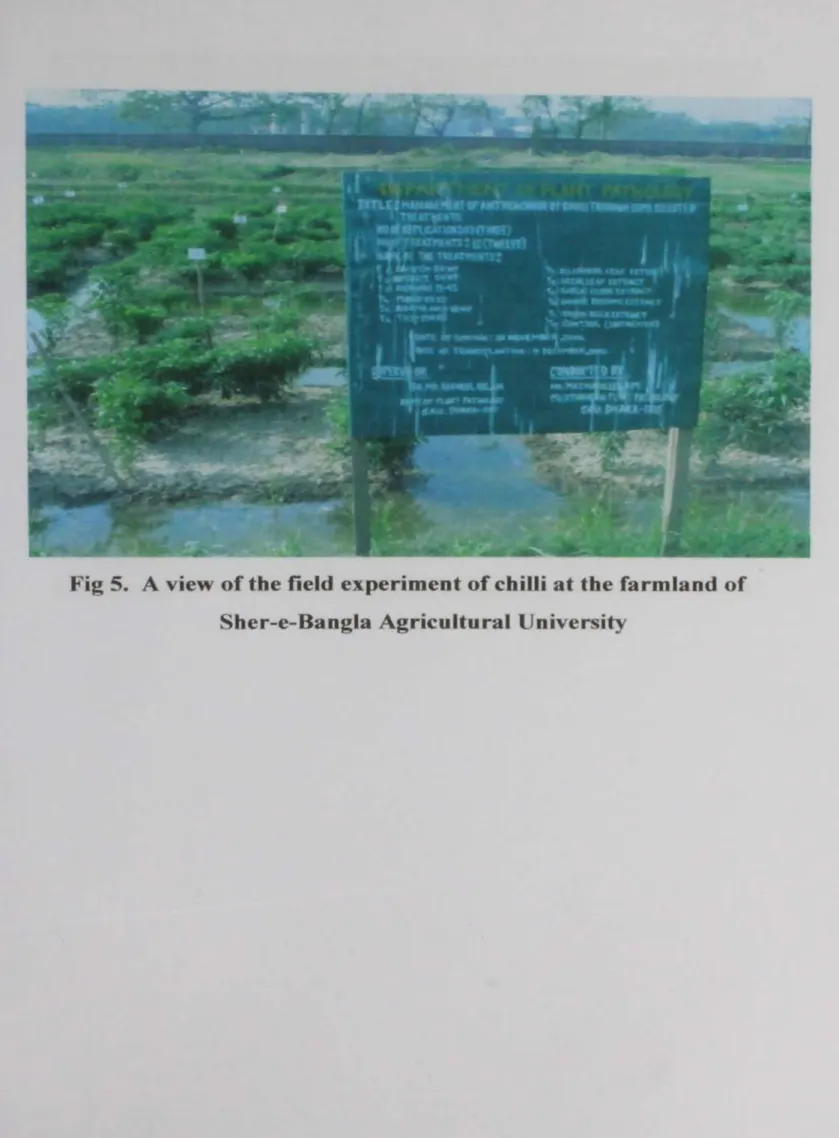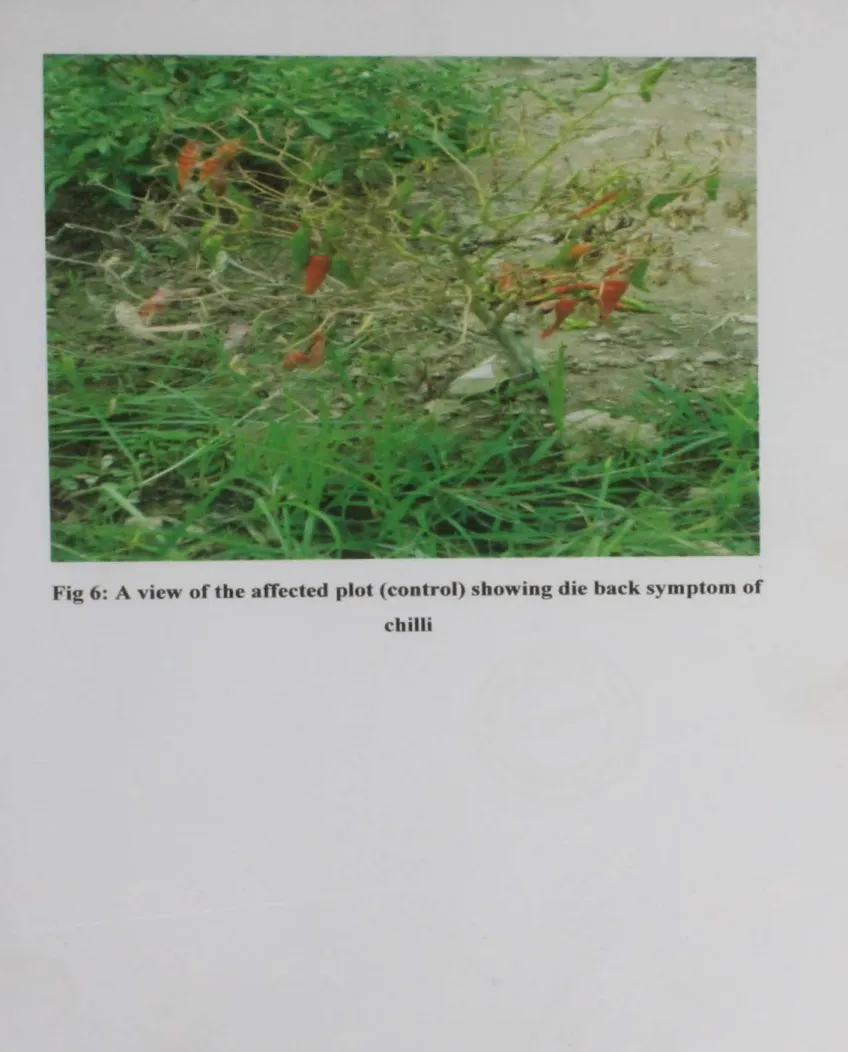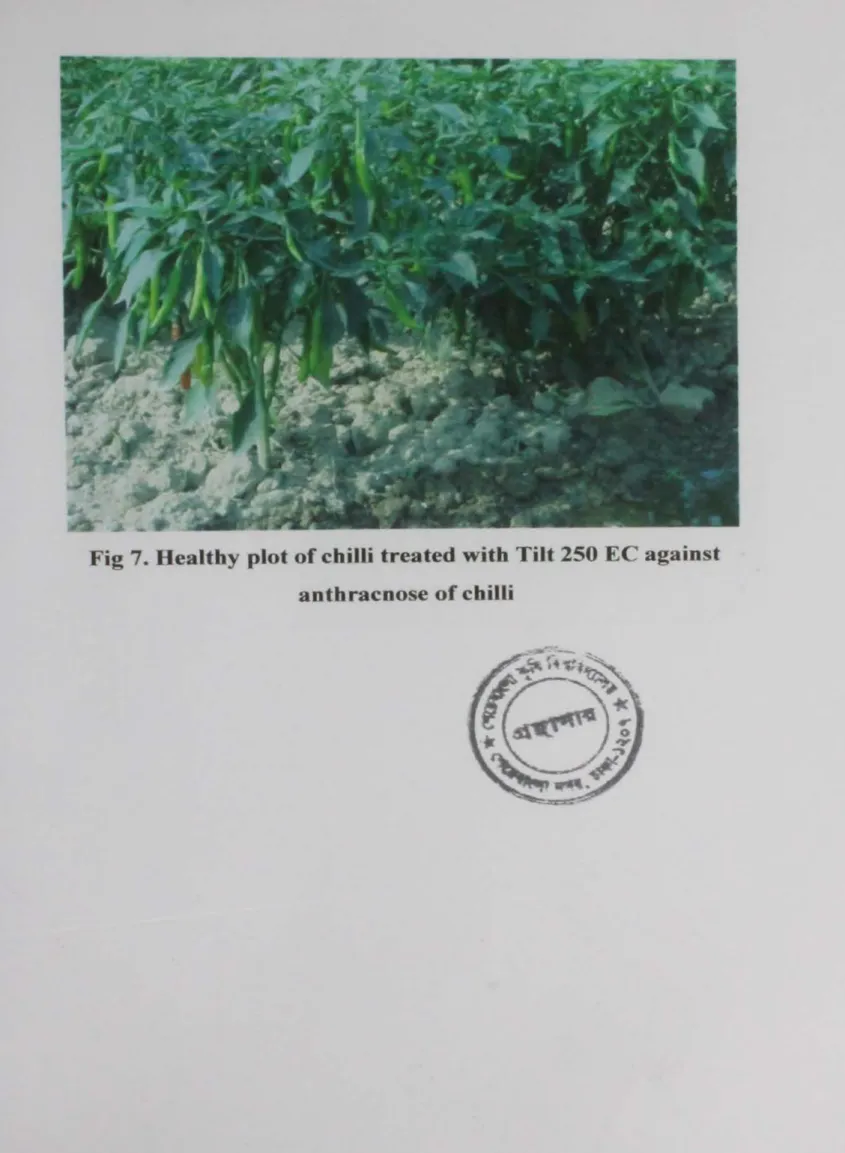DECEMBER, 2007
DEPARTMENT OF PLANT PATHOLOGY
SHER-E-BANGLA AGRICULTURAL UNIVERSITY DHAKA-1207
MUHAMMAD MAZHARUL ISLAM
REGISTRATION NO. 27565 I 00727BY
MANAGEMENT OF ANTHRACNOSE OF CHILLI THROUGH SELECTED FUNGICIDES AND PLANT EXTRACTS
DECEMBER, 2007 (Professor Mrs. Nasim Akhtar)
Chairman
Examination committee Department of Plant Pathology
(Dr. F. M. Aminuzzaman) Assistant Professor
Department of Plant Pathology Sher-e-Bangla Agricultural University,
Dhaka -1207 Co - Supervisor (Dr. Md. Raftqul Islam)
Professor
Department of Plant Pathology Sher-e-Bangla Agricultural University ..
Dhaka -1207 Supervisor
Approved by:
SEMESTER: JULY- DECEMBER, 2007 MASTER OF SCIENCE
IN
PLANT PATHOLOGY
}I
Thesis
Submitted to the PacuEty of Jtgricufture~
Sher-e-Banqia Jtgn"cu&ura['University, (J)fzak,a,
In
partial fu[fi[[ment of the requirements for the degree of
MANAGEMENT OF ANTHRACNOSE OF CHILLI THROUGH SELECTED FUNGICIDES AND PLANT EXTRACTS
By
MUHAMMAD MAZHARUL ISLAM
REGISTRATlON NO. 27565 I 00727
Superv isor
(Professor Dr. Md. Rafiqul Islam) Department of Plant Pathology Sher-e-Bangla Agncultural University
Dhaka-1207
---
Dated:
Dhaka, Bangladesh
I further certify that any help or sources of information, received during the course of this investigation have been duly acknowledged.
This is to certify that the thesis entitled,
''MANAGEMENT OF ANTHRACNOSE OF CHILLI THROUGH SELEGrED
FUNGICIDES AND PLANT EXTRACTS" submitted to the Department of Plant Pathology. Faculty of Agriculture, Sher-e- Bangla Agricultural University, Dhaka, in partial fulfillment of the requirements for the degree of
'M)lSPE<Jt OP SCl'EN(]E IN (J>L.Jl:NT(PjlTJ{OLO<;Jrt',
embodies the result of a piece of bona fide research
work carried out by
'MVJf,Jl'M'M)1(]) 'M}fz:Jf)4Ji(VL ISL.Jl'M, <R.§gistrationNo.
27565/00727,under my supervision and guidance. No part of the
thesis has been submitted for any degree or diploma in any institutes.
Cordial thanks and honors to Abu Noman Faruq Ahmmed. Lecturer, Department of Plant Pathology. Sher-e-Bangla Agricultural University, ft is a great pleasure for the author to extent his deep sense of gratitude and indebtedness to his honorable teacher Professor Mrs. Nasim Akthar, Department of Plant Pathology. Sher-e-Bangla Agricultural University, Dhaka for her creative and sincere co-operation in completing thesis
The author expresses his deepest sense of gratitude, indebtedness and sincere appreciation to his co-supervisor Dr. F. M. Aminuzzaman, Assistant Professor, Department of Plant Pathology, Sher-e-Bangla Agricultural University, Dhaka, for his valuable advice, constant
inspiration and helpful suggestions. lie took much pain to edit the thesis thoroughly and gave valuable suggestions for its improvement. His scholastic supervision and constant inspiration brought this thesis up to
its present standard.
All praises to almighty "Allah" Who enabled the author to complete the research work and thesis writing leading to Master of Science (MS) in Plant Pathology. The author expresses his grateful respect and wishes.
whole hearted gratitude and appreciation to his benevolent teacher and supervtsor Dr. Md. Rafiqul Islam. Professor, Department of Plant Pathology, Sher-e-Bangla Agricultural University. Dhaka for his precious suggestions, constructive criticism, proper guidance and helpful
comments through out the study. He took keen interest and intellectually guided the author to develop the conceptual framework of the study.
ACKNOWLEDGEM ENT
JI
Author
December, 2007
Finally, the author is highly indebted to his beloved parents, elder brothers A-Id. Mahmudul Islam. sisters Fahmida Begum and Shahnaj Begum for their sacrifices and inspirations to pursue education from beginning to the completion.
The author extends his heartiest thanks and special gratefulness to his friends, Tanvir Ali Siddique. Mintu, Iqbal. Attaur Rahman. Akkas Ali,
Do/on, Khaled, Salauddin. Monir, Mamun and many other well wishers for their inspiration. encouragement, help and active co-operation for
carrying out the present study.
The author is grateful to the office staffs of the Department of Plant Pathology and Farm Division at SAU, for their cooperation.
encouragement and help to complete the research work.
The author also expresses his cordial thanks and gratefulness to all other respected teachers of the Department of Plant Pathology, Sher-e-Bangla Agricultural University. for their valuable advices. suggestions and constructive criticism.
Dhaka .. for his helpful cooperation providing necessary facilities during the period of the research work.
J
CONTENTS
CHAPTER TITLE PAGE
ACKNOWLEDGEMENT
CONTENTS III
LIST OF TABLES VI
LIST OF FIGURES VII
LIST OF APPENDICES VIII
ABSTRACT IX
CHAPTER 1 INTRODUCTION
CHAPTER2 REVIEW OF LITERATURE 4
2.1 Management through fungicides 4
2.2
Management through plant extracts 12CHAPTER3 MATERIALS AND METHOD 18
3.1 Experimental site 18
3.2 Characteristics of soil 18
3.3 Weather condition of the experimental site 19
3.4 Experimental period 19
3.5 Cultivar's used in the experiment 19
3.6 Seed treatment 20
3.7 Incubation of seeds for germination 20
3.8 Raising of seedlings 21
3.9 Design and layout of the experiment 21
3.10 Treatments 21
3 .11 Land preparation 22
3.12 Application of fertilizer and manures 22
3.13 Transplantation care of seedlings 23
3.14 lntercultural operation 24
3.14. l Shading 24
3.14.2 Irrigation 24
3.14.3 Gap filling 24
3.14.4 Weeding 24
3.14.5 Use of insecticide 24
I\
35
35 35 34 34 32 32 29
29
30 30 30 30 30 31 31
31 31 28
28
29 24 25
26
28 Fungicides used
Preparation of fungicida] solution Plant extract used
Collection and preparation of plant extracts solution
Tagging
Application of fungicides and plant extracts Diseased symptoms observed in the
experimental plot Isolation of pathogen
Identification of fungal isolates Data collection
Total number of twigs/plant
Total number of infected twigs/plant Calculation of disease incidence of twig
Total number of leaves/plant
Total number of infected leaves/plant Calculation of disease incidence of leaf Total number of fruit/plant
Total number of infected fruits/plant Calculation of disease incidence of fruit Evaluation of leaf and fruit anthracnose
severity
Assessment of anthracnose of chilli
Isolation, purification and identification of the organism
Yield of chilli fruit
Cost Benefit Analysis and calculation of BCR (Cost Benefit Ratio)
Analysis of Data
PAGE
3.30 3.28 3.29 3.26 3.27 3.22 3.23 3.24 3.24. l. l 3.24.1.2 3.24. l.3 3.24.2. l 3.24.2.2 3.24.2.3 3.24.3.1 3.24.3.2 3.24.3.3 3.25 3.19 3.20 3.21 3.15 3.16 3.17 3.18
TITLE CHAPTER
MATERIALS AND MA TH ODES CONTD.
72
59 57 54
48
46 44 42 40 38
37 36 36 36
APPENDICES REFERENCES CHAPTER 7
SUMMARY AND CONCLUSION CHAPTER6
DISCUSSIONS CHAPTERS
4.9 4.8
4.74.6
4.5 4.4 4.3 4.2Symptoms of anthracnose of chilli as observed in the field
Isolation and Identification of the pathogen of Die back/ anthracnose diseases of chilli Effect of fungicides and plant extracts on
germination percentage of chiJli in lab.
condition
Effect of fungicides and plant extracts on germination percentage of chilli in seed bed Effect of different fungicides and plant
extracts on disease incidence and severity of anthracnose of chilli
Effect of different fungicides and plant extracts on die back (Twig infection) of chilli
Effect of different fungicides and plant extracts on fruit infection and lesion Fruit Area Diseased (FAD)
Effect of different fungicides and plant extracts on fruit yield against anthracnose of chilli
Cost analysis 4.1
RESULTS CHAPTER4
vi
Table Name of Tables Page
No. No.
1 Fertilizer and manure applied in
--
the field23
2 Particulars of the fungicides
used
an the25
experin1ent
3 Particulars of the plant extracts used 1n the
26
experiment
4 Effect of different treatment -- on seed
39
germination in the field condition5
Effect of different treatment on seed39
-germination in the lab. condition
-- -
6 Effect of different fungicides and plant extracts
41
on disease incidence and disease severity of anthracnose of chilli
- -
7 Effect of different fungicides and plant extracts 43 on die back (twig infection) of chiJli
- -
8 Effect of different fungicides and plant extracts
45
on fruit infection and fruit area diseased (FAD)
9 Effect of different fungicides and plant extracts
47
on fruit yield of chilli against anthracnose
disease -
10 Cost Benefit analysis of twelve different
49
treatments for controlling anthracnose of chilli --
LIST OF TABLES
FIG URE PA GE TITL E
l. Different Types of plant species used in the experiment 27
2. Disease Severity scale (0-5) 33
3. Severity affected fruits caused by
Colletotrichum50 caps1cl
4. Acervulus with setae, conidiophores and conidia of 50
Colletotrichumcapsici seen under compound
microscope ( 1 OX)
5. A view of the field experiment at the farm land of 51 Sher-e-Bangla Agricultural University
6. A view of the affected plot (control) showing die back symptom
7. Healthy plot treated with Tilt 250 EC 53
LIST OF FIGURES
VIII
76 Analysis of cost of application for management of
Anthracnose of chilli 6.
LIST OF APPENDICES
PPENDIX
PAGETITLE
1. Result of mechanical and chemical analysis of soil of the 72 experiment plot
2. Monthly average temperature, relative humidity and total 73 rainfall of the experimental site during the period from
October 2006 to May 2007
3. Composition of Potato Dextrose Agar (PDA) 73
4. Design of the experimental plot 74
s. Analysis of cost of application of common culture 75
practice in production of chilli plant
The effect of twelve treatments viz. Bavistin 50 WP (T1), Cupravit 50 WP (T2). Dithane M-45 (T3), Proud 250 EC (T4), Ridomil Gold (T5). Tilt 250 EC (T(l). Allamanda leaf extract (T7). Neem leaf extract (T8). Garlic extract (T9), Ginger extract (TIO)~ Onion extract (T11) and Control (T12) were tested against Colletotrichum capsici causing Anthracnose of chilli during winter season (2006-2007) at the Farm of Sher-e-Bangla Agricultural University, Dhaka. The highest seed germination (80%) was obtained from ginger extract and neem extract treated seeds in laboratory condition while the germination was 78.83o/o and 74.00%, respectively ginger and necm extract in the field condition. The efficacy of the treatments varied significantly in terms of disease incidence, disease severity and yield of chilli. Tilt 250 EC (T6), Proud 250 EC {T4), Cupravit 50 WP (T2) and Allamanda extract (T9) showed promising effect against the disease. Application of Tilt 250 EC increased 195.90% fruit yield of chilli followed by Proud 250 EC ( 177.59%) and Bavistin 50 WP (159.56%) against anthracnose disease of chilli. Cost benefit analysis showed that the application of Tilt 250 EC (T6) resulted the highest BCR (4.07) followed by Proud 250 EC (3.68). Bavistin 50 WP (3.47), Allamanda leaf extract (3.16) and Dithane M- 45 (2.95 ) compared to control.
ABSTRACT
MANAGEMENT OF ANTHRACNOSE OF CHILLI THROUGH SELECTED FUNGICIDES AND PLANT EXTRACTS
1\1TRnn
• •, ,_1 T Trr1f)\J
- .I •. •:' I ·'. ~ -~.,; ~' ' . . -~-- . ~l ~;.:....
CHAPTER ONE
Incidence of insect pests and diseases greatly hamper the production of chilli. This crop suffers from the various diseases; about 83 different diseases, of which more than 40 diseases are caused by fungus (Anonymous, 1960 and Rangaswami, L979). Among the fungal diseases, at least 31 diseases are transmitted through seeds (Richardson 1983, Deena and Chowdhury 1984 and Shanna 1985). Among the seed borne fungal diseases. anthracnose is one of the major and devastating disease of chilli
in the country. It is caused by Colletotrichum capsici (syd). In Bangladesh.
the disease is common in flooded low lands where Solanaceous spices are grown continuously without crop rotation.
Chilli (Capsicum annuum L.) belongs to the family Solanaceae is the most important spice crop in Bangladesh. It is cultivated in almost alJ tropical and sub tropical countries in the world. Chilli is grown in all parts of Bangladesh. Chilli fruits are consumed as fresh, dried or processed product, as table vegetables as well as spices or condiments. It is a rich source of vitamin A, E and C. Chilli contains 1.29 mg protein, 11 mg calcium, 870 IU. 17.5 mg ascorbic acid, 0.06 mg thiamin, 0.03 mg riboflavin and 0.55 mg niacin per I 00 mg edible fruit (Joshi and Singh, 1975). lt has an important role in both winter and summer to fulfill the spice demand of our country. Chilli is grown in all season and all areas of Bangladesh .The total cultivation area is 65000 hectare where 23417 ha in
Kharif season and 41583 ha in Rabi season with total production of 52000 MT and annually average yield is 0.80 MT in 2004-2005 (Anon., 2007).
Of many reasons for high price of chilli, lower production rate is an important factor.
INTRODUCTIO N
CHAPTER I
Botanical control of seed-borne pathogens of many crops tested in many laboratories and field trials showed that crude extract from rhizome, leaf, stolen fruits and cloves of garlic (Allium sativum), marigold (Tagetes erecta), neem (Azadirachta indica). dholkalmi (lpomoea fistulos.L.) and ginger (Zingiber officinale) could restrict growth of the seed-borne fungi.
It was found that garlic extract at different concentration significantly reduces seed borne Colletotrichum corchori, Fusarium spp and Macrophomina phaseolina in jute (Khan and Fakir, l 995). Neem extract minimize the ripe fruit rot of chilli. Garlic extract can effectively control chilli anthracnose (Harbant et al.. 1999). Colletotrichum capsici was effectively controlled by the leaf extract of Solanum torvum, Dutura mete/
and Prosopis juliflora (Gornathi and Kannabirran 2000). Thus, attempts need to be taken to manage the anthracnose of chill i through environment friendly plant extract including fungicides.
2
Management strategies for this disease include use of healthy seeds and transplants. resistant cultivars and fungicidal sprays. At present, plant diseases are mainly managed by the use of chemical fungicides. The indiscriminate use of chemicals is not only hazardous to living being but also breaks the natural ecological balance by killing the antagonist microorganisms. Now a day's induced resistance in plants against the pathogen is drawing the attention of plant pathologists for successful management of crop diseases. But the resistant variety of chilli against anthracnose diseases is not available. Among the control measures, seed treatment is probably the cheapest and safest method to control anthracnose pathogen. It is reported that Mancozeb and Carboxin completely controlled the seed- borne Alternaria altemata, Fusarium moniliforme and Colletotrichum capsici (Mridha and Chowdhury 1990).
2. To determine the Benefit Cost Ratio (BCR) of effective fungicides and plant extracts applied against anthracnose of chilli 1. To determine the efficacy of selected fungicides and plant extracts
against Colletotrichum capsici causing anthracnose of chilli.
Considering the above facts, the present study was under taken to achieve the following objects:
CHAPTER TWO
Ahmed ( 1986) recommended Delsan (0.2%) and Cuman-L (0.5%) against anthracnose of chili caused by Colletotrichum capsici; Bordeaux mixture against anthracnose of betel vine caused by Colletotrichum capsici;
Dithane M-45 (0.2o/o) against anthracnose of mango caused by Colletotrichum gloeosporioides and Copper oxychloride (0.3%) or Dithane M-45 (0.2%) against anthracnose of guava for the management of the diseases respectively.
Bhuiyan and Fakir (1982) got 90% control of Colletotrichum dematium and Macrophomina phaseolina when treated the soybean seeds with Captan (0.5%), Homai 80 WP (0.25%), Topsin M 70 WP (0.5%) and Vitavax-200 (0.35%) while all these fungicides contorlled 70 to 95%
seedling diseases caused by the two fungi in pot experiment. The found Hornai 80 WP and Captan as the best fungicide to control two major seed borne pathogen of soybean.
J uangbhanich and China ( 1975) observed that seed treatment with Ceresan (Ethoxyethylmercury) at 0.16o/o or Desline (Methyl 2- benzimidazole carbamate) at 0.8% of seed wt gave complete control of Colletrotichum peperatum and Colletotrichum capsici.
2.1 Management through fungicides
CHAPTER II
REVIEW OF LITERATURE
5
While working with anthracnose disease of guava caused by Colletrotichum gloeosporiodes, Hossain ( 1989) observed that Topsin M, Rovral 50 WP, and Rovral Flo completely inhibited the growth of the fungus. When applied on plant Topsin M significantly reduced fruit infection and disease severity followed by Rovral Flo, Rovral 50 WP and Dithane M-45. The author concluded that when the number of fungicidal sprays increased from 4 to 7 the fruit infection were reduced and fungicidal efficacy was significantly improved.
Perene and Joi ( 1989) found that the treatment of chilli seeds with Thiram or Bavistin and fungicidal spray of seedling with Dithane M-45, Blitox, Carbendazim were more effective than either of the single treatment in controlling Colletotrichum capsici . The incidence of the disease was least after seed treatment with Bavistin followed by spraying with Dithane M- 45. Fruit rot was less with combination effect of seed treatment with Thirum and spraying with Mencozeb.
Eswararnurthy et al. ( L 988) found that spraying of 10 fungicides twice at 15 days interval, the best control of Colletotrichum capsici on Capsicum annuum was given by Foltaf (captafol) at 0.2%, followed by Fytolan (Copper Oxychloride) at 0.25% and Bavistin (Carbendazim) at 0. l %.
These compounds also gave good control of the die-back phase of the disease and increased yields.
Thind and Jhooty ( 1987) stated that the most effective and economical control of Colletotrichum capsici and Alternaria alternata on Capsicum annuum under Panjab conditions given by sprays with Difolatan (Captafol) at 0.2 °/o, followed by Dithane M-45 (0.2 o/o).
Biswas ( 1992) found in the field trials of six fungicides, Bavistin, Mac sulpher, Dithane M-45, Knowin, Mancozeb and Thiram against Colletotrichum capsici on Capsicum annuum the best control was given by Bavistin 50 WP at 0.1 °/o concentrations.
Sinha (1990) observed on the field trials during 1984-87, with seven commonly available fungicides. The best control of Colletotrichum capsici on Capsicum annuum was given by using Folaf (Captafol). The best cost-benefit ratio was obtained with Dithane M-45 (Mencozeb) and Bilotox 50 (Copper oxychloride).
Raj et al. (1990) stated seed treatment with thiram
+
carbendazim followed by 3 sprays of carbendazim gave minimum disease incidence of anthracnose of bean ( Colletotrichum capsici) and maximum yield per plot.Seed treatment and 3 sprays of mancozeb also increased yield and reduced disease incidence. Srivastava and Soni (1993) reported that 0.1 o/o Bavistin and 0.25% Dithane M-45 (Mancozeb) were effective fungicides for the control of the disease under laboratory and field conditions.
Datar et al. ( 1990) conducted experiment on fungicidal control of anthracnose of chillies and found that in field trials over three consecutive seasons, ( 1984-87) three sprays of rnancozeb 0.25 %, fortnightly from one month after transplanting gave the best control of Collectotrichum capsici on the susceptible Capsicum annuum cv. Jwala, with highest yields and lowest incidence of fruit rot.
7
Kumawat ( l 997) conducted a field experiment at Jalore, India during the Kharif season, to evaluate eight fungicides against anthracnose disease of chilli. Three sprays of fungicides Mancozeb, Thiophanate- methyl, Catafol, Ziram and Carbendazim at 15 days intervals significantly reduced the
disease intensity.
Ebenezar and Alice (1996) conducted field experiments to study the efficacy of 9 commonly used fungicides in controlling fruit rot and dieback of chilli caused by Collectotrichum capsici in Tamil Nadu., India. The best control was achieved with Mancozeb (0.2%) followed by Carbendazim (0.2%) and Copper oxychloride (0.2%).
Acharya and Das (1995) conducted a field experiment for the control of Collectotrichum capsici causing anthracnose of Piper betel. Foliar spray of Bitertanol (0.05 o/o), Mancozeb (0.2%) Ziram (0.1 o/o) and Bordeaux mixture (0.5%) were found to be effective against the fungus. A higher cost-benefit ratio was observed for Mancozeb and Bordeaux mixture.
Rahman et al. (1994) evaluated Tilt 250 EC'.t Pencozeb 80 WP" Topsin-M 70 WP~ Knowin 50 WP and fungi-kill 50 WP against colletotrichum lindemuthianum causing anthracnose of country bean. Among the fungicide tested Knowin SOWP was found to be the best followed by Tilt 250 EC and Topsin 70 MP both in vitro and in vivo controlled of the Collectotrichum lindemuthianum. Tilt 250 EC was found to be the best performance followed by Knowin 50 WP both in vitro and in vivo
condition in controlling Colletotrichum dematium.
Hedge and Anahosur (2001a) also conducted a field experiment to determine the effective fungicidal treatment against fruit rot disease of chilli (Capsicum annuum) under rainf ed conditions. The efficacy of non-
systemic (Mencozeb, chlorothalofi l, Copper oxychloride, and Iprodione at 0.3°/o concentration) and systemic fungicides (Cardendazim, Tridomorph,
and Hexaconazole at 0.15% concentration) and botanical fungicide Nimbicidin at 3% were tested. Among the tested fungicide, Cardendazim showed the least percent disease index (30.96%), followed by Propicanazole (36.53%) and Hexaconazole (35.63%). lprodione yielded Saleem (2000) conducted a survey during 1996-1999 and more than 150 diseased Piper beetle specimens were collected in Thatta and Pakistan.
Colletotrichum capsici and Colletotrichum gloeosporides were isolated and identified. BenoyJ and Thiophanate-methyl gave good control of these pathogens.
Romer et al. (2002) conducted a series of field trial in Germany and in the Azores in 1998. Seed treatment and fungicidal spray had been tested for their efficiency to control anthracnose. They reported that the most efficient fungicides were "Harvesan" (Carbendazirn
+
flusilazole) +"Amistar" (Azoxystrobin) (Germany
+
Azores), "Simbo" (fenpropimorph + propiconazole) (Germany), "Alto 100 SL"+
"Bravo 500"(Cyproconazole
+
Chorothalonil) (Germany+
Azores), Folicur+
Bravo 500 (Tebuconazole+
Cholothalonil) (Germany), "Amistar" (Germany) and"Harvesan" (Germany
+
Azores).Haque et al. ( 1998) tested five fungicides against seed borne fungi of chilli and reported that Vitavax-200 totally eliminated the seed borne infections of Colletotrichum capsici and increased germination.
9
Deshmukh et al. (2002) conducted an experiment for comparison between Mancozeb at 0.25% and biological pesticide Zetron at 0.2~ 0.25 and 0.4%
in controlling anthracnose of chilli. The Zetron significantly reduced the growth of the fungus comparison to the control. The development of lesions on chilli fruits was considerably slower with the lowest lesions development resulting from the Mancozeb treatment followed by Zetron at 0.4, 0.25 and 0.2 o/o.
Oeeksha et al. (2002) found that chemical control of anthracnose of Vigna mungo where seed treatment followed by two prophylactic sprays of Bavistin (Carbendazim) or Tilt (Propiconazole) at 0.1 % concentration at 15 days interval showed minimum disease severity and maximum grain yield followed by spraying 1 % Contaf and 2°/o Indofil M-45 in the plots.
Hedge and Anahosur (2001 b) conducted an experiment on the control of chilli fruit caused by Colletotrichum capsic.i The fruits were treated with I Oo/o. 25o/o, 50% respectively and saturated solution of sodium chloride for l 0 15 and 30 minutes, stored in different storage conditions. They observed all treatments differed significantly regarding the to disease incidence. Treatment with sodium chloride at 50% concentration or saturated solution for 30 minutes reduced the disease in storage to the maximum extent. Storing chilli fruits after treatment with either 50% or saturated salt solution for 30 minutes under sunshine was the best from other in getting healthy dried fruit.
the highest percentage disease index (71.57°/o). Cardendazim was the best fungicide for controlling fruit rot disease. The fungicides also helped m obtaining maximum capsicin, ascorbic acid and total sugar contents m chilli fruits.
Ekbote (2003) conducted a field experiment during the 2000/0 l and 2001/02 kharif seasons in Karnataka, India to evaluate the efficacy of Prochoraz compared with Carbendazim and Mencozeb against fruit rot and die-back ( Colletotrichum capsici) of chilli. The treatments comprised of 0.05, 0.75, 0. 1 and .0125% Prochoraz 45 EC; 0.25% Mencozeb: 0.25%
Copper oxychloride 75 WP and .01 % Carbendazirn. Among these Rajabaskar et al. (2002) conducted three experiments to investigate the harvest time residues of Tilt 250 EC (Propiconazole) in local chilli cultivar. Propiconazole was applied at 125 and 250g a.i./ha, at 15 days interval; starting from 45 days after transplanting. The residues on the crop were analyzed from the sample collected 15 days and 30 days after application. The residues were extracted with methanol, cleared using dichloromethane (Methyl choloride) and analyzed by GC-ECD. The harvest time resudes of Propiconazole applied at recommended rate of 125 g a. i./ha were below the detectable limit 15 and 30 days after application while propiconazole applied at 250 g a.i./ha resulted in residue concentration of 0.074, 0.098 and 0.167 ppm.
Ekbote (2002) conducted an experiment against fruit rot of chilli to ev aluate the efficacy of Copper hydroxide at 0.10, 0.15, 0.20 and 0.25o/o;
Chlorothalonil at 0.20%; and Carbendazim at 0. 10%. The lowest disease index (30.47%) resulted from the application of 0.1 Oo/o Carbendazim (30.47) followed by copper hydroxide (37.70%) sprayed at 0.25 % concentration. Crop yield was the highest with application of Copper hydroxide (0.25 o/o). The results indicated the potential of using Copper hydroxide in controlling Colletotrichum capsici to avoid the development of the resistance of the pathogen to carbendazim.
I 1
Rahman et al. (2004) conducted on experiment in M) mensingh.
Bangladesh to evaluate the efficacy of Bion (0.005%), Azoxystrobin and Carboxin in inducing systemic resistance to Anthracnose ( Colletotrichum Capsici) in chili (Capsicum annuumy. Ihey observed die-back symptom did not appear in Bion treated seeds but was recorded in Azoxystrobin and Carboxin treated seeds. Lesion size, leaf infection and leaf area damage were less in plants grown from Bion and Azoxystrobin treated seeds. Bion Joi el al. (2004) conducted a field trial during kharif 2002/03. Maharastra in India to evaluate the efficacy of RlL 006/CI 0.05, 0. J, 0.15 and 0.2o/o concentration against anthracnose of chilli caused by Colletotrichum capsici. They also used Shan at 0.1 %. Contaf (Hexaconazole) at 0.3% and 0.1 %. They observed all treatments except for RIL 006/C l at 0.05% were significantly superior over the untreated control in reducing intensity of leaf anthracnose and fruit rot infection. RIL 006/Cl at .02%, Tata Shan at 0.1 %
+
Contaf at 0.3% and RlL 006/Cl at 0.1 % reduced anthracnose and fruit infection 70.7, 67. l and 62.6%, respectively over control.Mandal and Beura (2003) conducted an experiment on chilli cv. Utkal Ava at Orissa, India to determine the efficacy of different application dates of 0.05% Mono crotophos
+
0.25% Mancozeb against chilli thrips (Scirtothrips dorsalisy; anthracnose and ripe fruit rot (Cotletotrichum capsici). The pesticide combination was applied at 25, 45 and 65 days after transplant (DAT)~ at 25 and 45 at 25 and 65, and 45 and 65 DAT~ and at 25, 45 and 65 DAT. Leaf curling rate, percent disease index (POI) of anthracnose and PDI of ripe fruit rot were reduced.fungicides 0.125% Prochoraz gave the lowest POI for die back and fruit rot and highest yield performance.
Ahmed and Sultana (1984) used bulb extract of garlic at different concentration that inhabited the spore germination and mycelial growth of some important fungal pathogens of jute such as Macrophomina phaseol ina, Botryodiplodia theobrome and Colletotrichum corchori. Jute
seeds treated with garlic paste had increased rate of germination and decreased rate of post emergence seedling mortality.
Misra and Dexit ( 1977) reported the fungitoxicity of garlic bulb and they showed that they showed that garlic extract could be used be as a potent fungicide against plant pathogens in vitro.
2.2 Management through plant extract and phytoncydes
Roy (2005) sprayed eleven fungicides for four times at ten days to control Colletotrichum capsici on chilli (Capsicum annuum). Fild 250 EC at 0.05%, give the effective result followed by Propicon 250 EC, Copper 50 WP and Indofil Z-78. These compounds also could control of the die back phase as well as anthracnose disease and increased yield of chilli.
Anon. (1985-2005) conducted an experiment to evaluate the fungicides namely, Indofil, Dithane M-45, Topsin Mand Tilt 250 EC for controlling the anthracnose of chiJli. Data indicated that incidence of antbracnose significantly lower in Topsin M treated plot which was significantly similar to Indofil sprayed plot. Tilt 250 EC and Dithane M-45 were also effective.
treatment resulted m moderate resistance to anthracnose, where Azoxystrobin and Carboxin treatment resulted in susceptibility of the crop to the disease.
13
Dubey and Dwivedi ( 1991) observed fungitoxic properties of extracts of leaves and bulb of onion, garlic and fruit and bark extract of Allium According to Tariq and Magee {1990) volatile components of crude aqueous extracts of garlic bulb was effective in inhibiting germination of micro conidia and reduction of hyphal extention of F. oxysporum
f
lycopersici in anemic culture.
Lakshmonsn et al. (1990) found that garlic clove extract was most effective in inhibiting mycelial growth and spore germination of Corynespora cassiicola.
Kasem and Vijai (1987) tested the effects of some medicinal plants on growth of fungi and found potential in plant disease control. Ten medicinal plants. Sternona, nux-vomica tree, derris, urging croton .. star anise, clove tress. garlic and care way were tested for this antifungal property to some fungal species namely-Phytophthora spp., Phythium aphanidermatum.
Rhizopus microsporus. Alternaria alternata and Fusarium solani.
Staranise at the concentration of 2000 ppm completely inhibited growth of all test fungi followed by caraway, lemon grass, clove tree and garlic, respectively
Assadi and Behroozin ( 1987) found that garlic extract was more active than onion inhibiting the growth of Fusarium solani, Fusarium oxysporum and Fusarium acuminate.
Mali and Joi ( 1985) tested seven fungicides against seed borne mycoflora of chilli and reported that Vitavax-200 (carbendazim) was the most effective against colony growth and sporulation Colletotrichum capsici.
Mohanty et al. ( 1995) investigated the allelopathic control of Phomopsts vexans. causal agent of Phomopsis fruit rot of brinjal by aqueous leaf extracts of five plants. Fungal growth was inhibited to a maximum by leaf extract of Allamanda cathertica (93.75°/o) followed by Aegle merme/os (85.38o/o). Leaf Arun et al. (1995) found that the extract of garlic bulb was effective m suppressing radial growth of Fusarium sp and Colletotrichum capsici
Hossain and Schlosser ( 199 3) found neem extract to be effective against Bipolaris snrokiniana.
Fakir and Khan ( 1992) reported that garlic bulb extract al different concentrations reduced the seed borne infection in jute. Both concentrated garlic extract and Vitavax-200 were more or less equally effective in controlling M phaseollina reducing 90.9% and 87.9o/o seed borne infection ofthe pathogen, respectively.
Ac hi m u and Schloesscr (1992) studied the effect of neem seed extracts against downy mildew (Plasmopara viticola) of grapevine. They found that raw neem seed extract and commercial neem products (margo- san-O, neem oiJ and neern- Azal-S) had high (80-90%) antifungal properties against P. viticola. They concluded that the antifungal property of neem products could be attributed to an inhibition of the indirect germination of sporangia,
cearavica against vegetative growth and sclerotial viabil ity of Macrophomina phasttol ina. They a I so found that a J I the extracts
inhibited growth of the fungus while garlic bulb extract was more effective than other extracts employed in the tests.
15
Singh et al. (1997) evaluated plant extracts of Catharanthus roseus, Azadirachta indica, Pongamia pinnata, Tagetes erecta and onion bulb extracts and garlic extract at I, 2, 3 and 4% concentrations for radial growth and spore germination of Colletotrichum capsici, causing of dieback of Chilli (Capsicum sp.). Extracts of garlic bulb at 3%
concentration completely inhibited the growth and spore germination of C.
capsici whereas, 4o/o extracts of onion bulbs, A. indica leaf. P. glabra leaf Kurucheve and Radmavathi ( 1997) assayed five selected plant products for
fungi toxicity against Pythium aphanidermatum (Edson) Fitz, the casual organism of damping off of chillis, Among them extract from Allium sativum (garlic) bulb ( l Oo/o) recorded the minimum mycelium growth
(176.00 mg) followed by Lawsomia incemis leaf extract. Maximum percentage of seed germination, growth and vigor of chilli seedlings were also observed with garlic bulbs.
Panda et al .• ( 1996) tested the efficacy of leaf extracts from Polyalthia /ongijlora. Aeg/e mermelos, Azadirachta indica, Catheranthus roseus, Ocimum sanctum and Allamanda cathertica for control of Phomopsis blight (caused by Phomopsis vexans). Leaf extracts of A/lamanda cathertica had excel lent potential as a fungicide.
Kuprashvile (1996) used extracts of garlic bulb for seed treatment of eggplant infected by Phomopsis vexans .The results showed that the plant extracts disinfected seeds and increased yi e Ids.
extracts of Catheranthus roseus, Polyalthia longiflora and Azadirachta indica were equally effective. but that of Ocimum sanctum was the least effective causing 52.23o/o growth inhibition.
Khan (1999) studied the effect of plant extracts (Allamanda, Bel and Neem) for the management of Phomopsis blight/fruit rot of eggplant in field condition. Among the three plant extracts, Allamanda was the most effective.
Harbant et al. (1999) evaluated some plant extracts for the control of Colletotrichum capsici (SYD). The efficacy of neem t.Azadirachta indica), garlic (Allium sativum) and Tagak-tagak (Rhinocanthus indica) at 5000 ppm on Capsicum anmuum was compared with the fungicide carbendazim (Bavistin) at 100 ppm. Garlic extract performed well under room humidity, while Tagak-tagak extract showed good control of Chi Ii anthracnose under high moisture conditions. Neem extract minimized the ripe fruit rot of chilli.
Moniruzzaman and Ashrafuzzaman ( l 998) applied garlic (Atlium s ut.ivum}, neem (Azadirachta indica) and tobacco (Nicotiana tabacum) extracts against Alternaria blight of mustard- Crude extracts of these three plants were significantly reduced disease incidence and severity. ln promoting plant height number of siliqua per plant, number of seeds per s i l iqua, thousand seed weight and yield per plant were observed and the garlic bulb extracts ( l: 1) was the best among the treatments.
Khan et al. (1998) applied four neem based products, namely Nemokil, Nernokil-S, SOS and SOC and found anti fungal activity against the guava w i It and the anthracnose pathogen. These neem based products however, proved less effective against Colletotrichum gloeosporioides.
and T. erecta leaf gave complete inhibition of fungal mycelial growth and spore germination.
17
Y esmin (2004) reported that Neem leaf extract was most effective in controlling canker of leaf and fruit caused by Xanthomonas citri. Garlic extract and Neem leaf extract were the most effective in controlling die back of twig and branch of citrus respectively. She also recommended that citrus canker can successfully controlled by Neem leaf extract and garlic extract.
Islam (2004a) found garlic bulbs and allamanda leaves extract caused 76- 100% inhibition of mycelial growth of Phomopsis vexans. Diethyl ether, Dichlorornethane and water acted as effective solvents for spraying garlic extract. TLC studies showed the presence of a number of compounds having very low to high polarity in garlic bulbs and allamanda leaves extracts.
Kumaran et al. (2003) evaluated chemical fungicide Mancozeb at 320 ppm and ethanolic extract of the roots of 18 different plant species for their fungi toxic activity against anthracnose of chilli. They observed ethanolic root extract of A brus precatorious and Rauvolifia tetraphylla showed significant inhibitory effects on both the conidial germination and radial growth of Colletotrichum capsici.
Meah (2003) reported that garlic bulbs extract (1:10) and allarnanda leaves extract efficiently controlled Phomopsis vexans in the laboratory, nursery house and in the field reducing severity of leaf blight and fruit rot by 7 I- 75o/o.
Howlader (2003) observed that seed treatment with allamanda leaf extract (I: 1) effectively increased germination of eggplant seeds and tremendously decreased nursery diseases.
18
The soil of the experimental area was non calcareous dark grey and belongs to the Modhupur Tract (UNDP, 1988) under AEZ 28. The selected plot was medium high land and the soil series was Tegaon (FAQ, 1988).
The p11 of the soil was 5.8. The characteristics of soil under the experimental plot were analyzed in the SRDI. soil testing laboratory, Khamarabari, Dhaka and the details of the soi) characteristics are presented in Appendix J.
3.2 Characteristics of soil
The experiment was conducted in the Plant Health Laboratory of the Department of Plant Pathology of Sher-e-Bangla Agricultural University and the farm of the Sher-e-Bangla Agricultural University, Dhaka-1207 (Fig. 5). The Site of experimental plot lies in the 23° 74 N latitude and 90 ° 35 E longitudes with an elevation of 8.2 meter sea level (Anon. 1989).
3.1 Experimental site
A field experiment was conducted in the farm of Sher-e-Bangla Agricultural University, Dhaka. Bangladesh during the period of Novernber'Oo to May'07 for the management of anthracnose of chilli through some fungicides and plant extracts. The detail materials and methods of this experiment are presented in this chapter-
C HAPT ER Ill
MATE RI ALS AND METHODS
Chilli (Capsicum annuum L.) variety Bangla Lanka (BARl Morich-l ) was
used in the experiment. The seed were collected from regional spice center, Bangladesh Agricultural Research Institute (BARI) at Joydebpur Gazipur.
3.5 Cultivar's used in the experiment
The experiment was carried out during Rabi Season in 2006-2007 starting from November '06 to May' 07.
3.4 Experimental period
The geological situation of the experimental site was under the subtropical climate, characterized by three distinct seasons, the monsoon or rainy season from November to February and the pre- monsoon period or hot season from March to April and monsoon period from May to October (Edris et al, .1979). Average monthly maximum and minimum temperature were 25.3°C and l 1.15°C respectively. Details of the metrological data of air temperature, relative humidity, rainfall and sunshine during the period of the experiment was colJected from the Bangladesh Meteorological Department (Climatic Division) and presented in Appendix 2.
3.3 Weather condition of the experimental site
20
0 . • No. of genninated seed Vo Germination - No.of totaJ seed "' 1 00
In field condition, two hundred seeds were sown in seedbed after seed treatment. First germination or emergence was observed on 11th
November 2006 and first data were recorded on the 3rd December 2006.
Data recording were repeated four times with seven days intervals. The germination percentage was recorded using the following formula:
In the lab condition. the effect of different fungicides and plant extracts on seed germination was determined by the blotter method according to International Rules for Seed Health Testing (Anon -, 1976). Twenty five seeds were plated on 3 layer moist blotter paper in 9 cm petri dish maintaining uniform distance. The blotters and Petri dishes were sterilized properly before plating. Plating was done on the 29th November 2006. The plates were incubated at 25 ± 4°C temperature for 21 days or three weeks.
After incubating, data on the seed germination were recorded. Each treatment was followed by this procedure separately. Data were recorded three times with seven days interval.
3. 7 Incubation of seeds for germination percentage
Seeds of chilli were subjected to seed treatment. Two hundred seeds for each treatment were soaked or dipped for 12 hours in fresh water. Two hundred seeds of each treatment were dipped into the respective solution separately for seed treatment. Seeds were soaked for five minutes. After soaking, seeds were transferred to a newspaper sheets for drying. Then it was ready for sowing in the seedbed.
3.6 Seed treatment
Twelve different treatments designated by T., T2, T3 .. T,,, Ts. T6, T1, Ts, T9.
T 10, T
11 and T 12 were employed in the experiment. The treatments consist of six fungicides and five plant extracts and a control. The treatment were as follows-
The field experiment laid out in the Randomized Complete Block Design (RCBD) using three replications. The field was divided into three blocks with 12 unit plots in each. The size of the individual unit plot was 2.0 m x
1.5 m. Block to block and plot to plot distance were 1.0 m and 0.5 m
respectively. Layout of the experimental field was presented in Appendix - 4.
3.10 Treatments
3.9 Design and layout of the experiment
Seedlings were raised in Farm's seedbed of Sher-e-Bangla Agricultural University with proper care and management. The seedbed was prepared by mixing of Urea, TSP, MP, Furadan 3G and well decomposed cow dung.
The seed was sown in seedbed and covered with soil. Before sowing seeds were treated with different assigned treatment and create worm condition for quick emergence. The seeds were sown on 03 November, 2006. Two hundred seeds were sown for each treatment. Watering was done to maintain the soil moisture. Shade was provided to save the young and delicate seedling from heavy showering and scorching sunlight. (Islam, 2005)
3.8 Raising of seedlings
3.12 Application of fertilizer and manures
The land was prepared by thoroughly ploughing and cross ploughing with a power tiller followed by laddering. The weeds and rubbishes were removed from the field. The bigger clods were broken and leveled properly
into fine soil particles for seedling transplanting.
3.11 Land preparation
After opening the land well decomposed cowdung was applied and thoroughly mixed with soil through frequent ploughing. Before final land preparation inorganic fertilizers were applied. Fertilizer and manure were applied on the basis of chilli production manual (Anon., 2005).
T1
=
Bavistin 50WP T2=
Cupravit 50WP T ~ = Dithane M-45 'r, Proud 250EC T5 Ridomil Gold T6= Tilt 250 ECT7
=
Allamanda leaf extract T8=
Neem leaf extract T9=
Garlic extract T 10=
Ginger extractT11 =Onion extract
T12= Control (Untreated)
Healthy and uniform sized seedling of 45 days old were uprooted from the seedbed in the treatment wise by avoiding any injury to the roots and transplanted on 19 December 2006 in main field (Bose and Som, 1990).
Twenty seedlings were transplanted in each plot in the afternoon. For easy lifting of the seedlings from the seedbed moistened enough before uprooting. Watering and news paper shading of the seedlings was done in every morning for the first seven days after transplantation. After establishment of the seedlings, the soil of the plot was loosened from time to time with the help of a khurpi. For the proper establishment of the roots
and shoots watering was done up to the harvest as and when necessary.
3.13 Transplantation and care of seedlings
2. Urea and remaining half of MP applied in three installments as top dressing.
1. All cow dung, TSP, Boric acid, Gypsum and Zinc Sulphate and half MP applied during land preparation.
Fertilizer or manure Amount/ha Required amount for -
3.0 sq m plot in gram
~
Urea 2l0Kg 150g - -
TSP 300 Kg 350g
.__
MP 200Kg 75g
- --
Boric acid 05 Kg 2.5g
Gypsum 110 Kg 125g
Zinc Sulphate 15 Kg 5g
Cow dung 10 Ton 300g
Table l. Fertilizer and manure applied in the field
Six fungicides viz. Bavistin 50 WP, Cupravit 50 WP, Dithane M-45, Proud 250 EC. R..idomil Gold, and Tilt 250 EC were used in the experiment.
Details of the fungicides used are given next page:
3.15 Fungicides used
3.14.5 Use of insecticide: Aktara 0.2o/o was sprayed used @ three times starting from 15 days after transplanting (DAT) followed
by flowering stage and 80 DAT to control chilli aphid and whitefly.
3.14.4 Weeding: Weeding was done just before fertilizer application.
Weeding was done four times al 25 DAT, 45 DAT. 80 DAT and IOODAT.
24
3.14.3 Gap filling: Gap filling was done when any seedling failed to
established and died in the field. More than 50 seedlings were re-transplanted to fill the gaps.
3.14.2 Irrigation: Watering was done immediately after transplanting
the seedlings and continued up to 7 days to keep the soil moisture in suitable condition. The field plots were irrigated five times at 15 DAT (Day after transplanting), 40 DAT, 65 DAT, 80 DAT and 110 DAT.
3.14.1 Shading: Transplanted seedlings were covered with news paper cap (hand made) to protect the delicate seedlings from scorching heat of sunlight.
3.14 lntercultural operation
Fungicide solution were prepared dissolving require amount of fungicides with plain water to get proper concentration in 2000 m1 beaker or bottle.
Bottles were labeled appropriately. Before using the prepared solution were shaken thoroughly.
3.16 Preparation of fungicidal solution:
Common Chemical name
--
Active ingredient Dosename used
- -
r,
Bavisrin Methyl-2- Carbendazim 50% 1 g/litre50WP Benzamidazole
Carbamate Cupravit
-
T2 Copper oxychloride Copper oxychloride
7
g/litreSOWP (CuOCli) 50%
T3 Dithane M-45 Manganous ethylene Dithiocarbarnate 4.40 bisdilhio - carbamate (80%) g/litre
r,
Proud 250 EC Propiconazole Propiconazole 25% 1 ml/litre Ts Ridomil Gold Mencozeb+Metalixil 4% Mencozeb +68% 2 g/litreMetalixil
\r6
Tilt 250 EC Prop iconazo le Propiconazole 25o/o 0.5 ml/litre able 2. Particulars of the fungicides used in the experimentTreatment Common Scientific name Plant Dose used
Name parts used (ration)
T1 AJlamenda Allamanda cathartica - Leaf 1 :4
Ts Neem Azadirachta indica Leaf I :4
T9 Garlic A Ilium sativum Clove I :4
Tm
Ginger Zingiber officinale - Rhizome 1:4T11 Onion Allium cepa Bulb 1 :4
T12 Plain water - -
-
26
Table 4. Particulars of plant extracts used in the experiment
Five plants extract viz. Allamanda leaf extract, Neem leaf extract. Garlic extract, Ginger extract and Onion extract were used in the experiment (Fig.
1) Details of the plant extract used are given below:
3.17 Plant extract used
Pig 1. Different types of plant species used in the experiment
A. Allamanda plant, B. Neem leaf, C. Garlic Clove, D. Ginger rhizome and E. Onion bulb) E: Onion bulb
D: Ginger Rhizome
C: Garlic Clove
B. Neem Twig A. Allamanda Plant
All fungicides and plant extracts were sprayed with compressed hand sprayer. Three plots were sprayed with each fungicides and plant extracts
First spray was done in 22 February, 2007. The plants under respective treatments were sprayed five times at 15 days intervals. Required amount of spray solution was appJ ied per plant covering branches. leaves and fruits properly. Plants of control plot were sprayed with plain water only.
Precautions were taken to avoid drifting of spray materials to neighboring plants with polythene barrier.
Five plants were selected randomly from each plot for determining of leaf infection. leaf area diseased, twig infection, fruit infection and fruit area diseased.
3.20 Application of fungicides and plant extracts 3.19 Tagging
Five plants extract namely Allamanda leaf, Neem leaf, Garlic, Ginger and Onion were used in this study. For extraction of juice, required amount of respective parts of each pant parts were taken, washed in tap water and crushed in a rnortar and pestle. The crushed materials were blended in an electric blender adding double amount of water for I: 2 solution. The blended materials were filtered through sterile cheesecloth. The supernatant was diluted in equal amount of sterile water for 1: 4 solutions.
The extracts were labelled and shaken thoroughly before use.
28
3.18 Collection and preparation of plant extracts solution
Fungi growing out m the culture media were transferred to fresh PDA plates. The fungal isolates were then sub cultured on 2o/o water agar and purified by hyphal tip culture method. The fungus was identified following the appropriate keys (Kulsherestha et al., 1979 and Sulton, 1980).
3.23 Identification of fungal isolates
Infected leaves, twigs and fruits were collected for Isolation of the fungi.
Stem piece, 1 cm in length was cut out from the twigs for isolation. Four pieces of infected tissue approximately 10 mm in length and 1.5-2.5 mm width were surface sterilized in Chlorox ( l 0%) solution for 45 seconds and washed thrice in sterile water. The inocula were then placed on acidified Potato Dextrose Agar (PDA) (Appendix.3) medium in pertri dishes aseptically. After planting, the petri dishes containing the inocula were incubated at room temperature (26°C ± 2°C) under 12 hours light alternating with I 2 hours dark. The plates were incubated for 7 days in the inoculation chamber
3.22 Isola tioo of Pathogen
The plants were routinely observed from the time of spraying. Onset of new infection was recorded and symptoms of the anthracnose were observed, recorded and photographed.
3.21 Diseased symptoms observed in the experimental plot
30
scheduled.
Number of total leaves was recorded at different observation dates as 3.24.2.1. Total number of leaves/plant
. . . _ Number of infected twig x
Disease incidence -Total number of observation (twig) 100
3.24.1.3 Calculation of diseased incidence of twig antbracnose of different treatments
The percent diseased incidence of twig anthracnose was calculated using the following formula.
Number of infected twigs/plant under each treatment was counted at different observation dates as scheduled.
3.24.1.2 Total number of infected twigs /plant
Number of total twigs/plant was counted from randomly selected five plant from each plot at different dates as scheduled.
3.24.1.l Total number of twigs/plant 3.24 Data collection
Data were collected in the morning on the following parameters:
scheduled.
Number of total fruit was recorded at different observation dates as Number of anthracnose infected fruits/plant under each treatment was counted at different observation dates as scheduled
3.24.3.2 Total number of anthracoose infected fruits/plant scheduled.
Number of total fruit was recorded at different observation dates as 3.24.3.1 Total number of fruit/plant
. . . _ Number of infected leaves
Disease incidence - Total number of observation (leaves) x 100
The percent diseased incidence of was calculated using the following formula.
3.24.2.3 Calculation of diseased incidence of leaves caused by anthracnose of different treatments
Number of anthracnose infected leaves/plant under each treatment was counted at different observation dates as scheduled
3.24.2.2 Total number of infected leaves /plant
32
Grade 0/o area infected 0 - No infection
I - Up to 5 % area infected
2 - 5.1-12.0o/o areas infected 3 - l2.l-25.0% areas infected
4 - 25.1-50.0% area infected and 5 - Above 50. l % area infected.
The grade is given below
Percent leaf area diseased (LAD) and fruit area diseased (FAD) were measured. Area of a sing]e leaf /fruit was considered as I 00%. Deducting the healthy area, the diseased area was estimated. Average of% LAD and FAD was then calculated dividing the total disease areas by total number of investigated leaves/fruits (Islam et al., 200 I). The leaf and fruit anthracnose severity was recorded following 0-5 scale with slight modification as designed by Basak ( 1997) (Fig. 2).
3.25 Evaluation of leaf and fruit anthracnose severity Number of infected fruits
- Total number of observation (fruits) x 1 OO Disease incidence
The percent diseased incidence of was calculated using the following formula.
3.24.3.3 Calculation of diseased incidence of fruits caused by anthracnose of different treatments
0
=
0°/o Fruit Area Diseased (FAD) 1=1-5% Fruit Area Diseased (FAD) 2 = 5.1 -12.0 Fruit Area Diseased (FAD) 3 = 12.1 -25. Fruit Area Diseased (FAD) 4=
25.1 -50.0 Fruit Area Diseased (FAD) 5=
>50.1 Fruit Area Diseased (FAD) Fig 1. Diseased severity scale (0-5)34
Pure culture of the organism was prepared by means of hyphal tip culture method aseptically and repetition of sub-culture into PDA to at least 3-5 times. Colony characters, mycelial growth, color and sporulation of the fungi were studied and identified the organism following the methods of Singh ( 1982).
Diseased fruit with typical symptom was collected for isolation of the organism in the laboratory. Potato Dextrose Agar (PDA} (Appendix 3.) media was prepared and transferred to glass petridishes. The fruit samples were cut into small pieces. Each pieces contained diseased and healthy tissue. Surface sterilization of the pieces with chlorox (I: 1000) for 1 minute was done followed by three washes with sterile water and was placed onto PDA media in petri dish. The plates were incubated at 28+ 1 °C
for growth of the fungal colony.
3.27 Isolation, purification and identification of the organism
oz L f ti . . c. • Number of infected leaves or fruits
z o ea or run area mrecuon
=
T t 1 b f 1 f . x 100 o a num er o eaves or ruitsFive-plants/ plot were randomly tagged for recording infection. On the expression of the symptoms as leaf infection, fruit infection. lesion area on fruit was taken at 15 days interval after application of treatments. Total number of leaves or fruits and number of infected leaves or fruits was counted to calculate the percent leaf or fruit infection. The disease incidence was recorded using the methodology followed by Basak et al (1990, I 991 )
3.26 Assessment of anthracnose of chilli
The data on various parameters were analyzed using analysis of variance to find out the variation obtained from different treatments. Compilation of the experimental data and analysis were done by the computer MST A T-C program fol lowing the statistical procedures of Gomez and Gomez ( l 983 ).
Treatment means were compared by DMRT (Duncan's Multiple Range Tests).
3.30 Analysis of data
Gross return (Tk/ha)
BCR= Total cost of production (Tk/ha)
Costing of application of different fungicides and plant extracts for management of anthracnose of chilli was done based on the current market price of input, rate of hiring labor and agricultural machineries. Price of the field product was determined on the basis of current market value (Appendices 5 and 6). Estimation of Benefit Cost Ratio (BCR) was done according to Gittinger ( 1982) and Islam (2004) using the following
formula-
3.29 Cost Benefit Analysis and Calculation of benefit cost Ratio (BCR) The weight of fresh and ripe fruits per treatment was recorded at the time of every harvest. where harvesting was done with four times. The weight of fruits per plot was recorded and converts into per hectare yield.
3.28 Yield of Chilli fruit
Cup / Groove method: From a PDA plate three 5 mm discs of the medium were scooped from three places maintaining an equal distance
from the centre by a sterilized disc cutter. One milliliter of plant extract I fungicides solution was put into each hole and the plates were stored overnight in refrigerator for diffusion of the input in the medium around the hole before resumption of fungal growth. The next day, one 5 mm a. Isolation and identification of Colletotrichum capsici from
diseased specimen.
b. Bioassay of plant extracts and fungicides against Colletotrichum capsici
4.2 Isolation and Identification of the pathogen of Die back/
anthracnose diseases of chili
The symptoms of this disease appeared on ripened fruits and therefore sometimes the disease is caUed "Ripe fruit rot". Circular and sunken lesions with black margins appeared on the ripe-fruits. Pinkish masses of spores covered the sunken spot. In the advanced stage of the disease, the concentric markings with dark acervuli appeared on the affected parts. The spotted fruits dropped down prematurely and resulted heavy losses. The fungus also attacked the fruit (Fig. 3)
